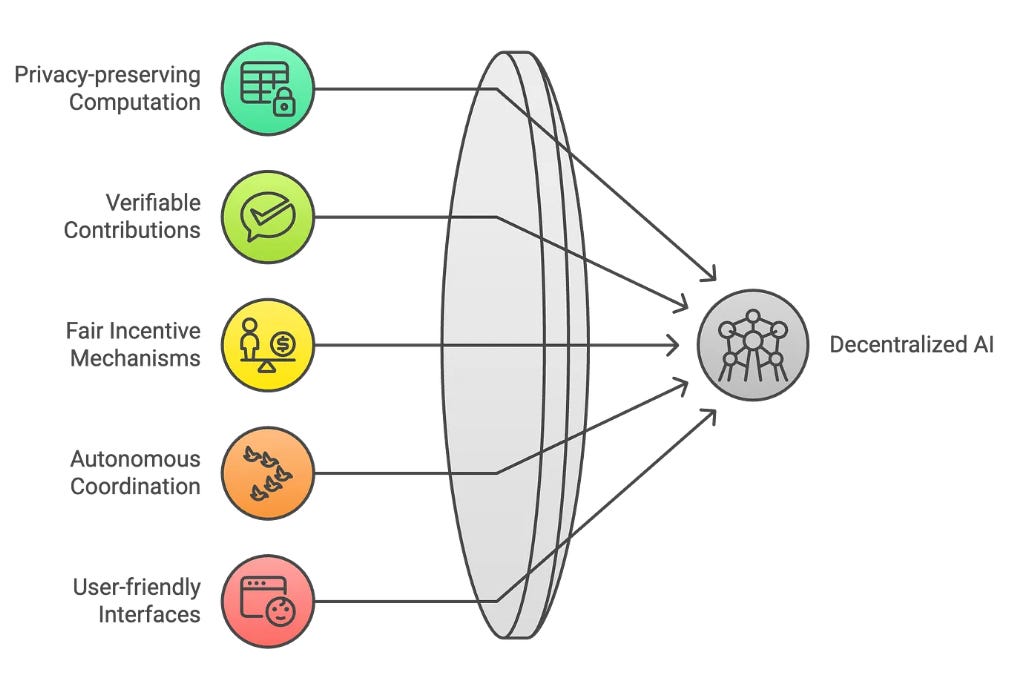Four For Friday | July 25, 2025
LF183 | MIT seeks to decentralize AI, networks > firms, AI anxiety, upside of global aging + Delphi.ai
Welcome to this week’s Four For Friday. Here’s four things that have piqued my interest this week, together with a bonus: AI Tip of The Week.
1. MIT’s NANDA aims to break up AI monopoly
MIT’s NANDA (Networked Agents and Decentralized AI) initiative aims to decentralize AI, and break up the stranglehold of the billionaire tech companies. However, this approach faces a bunch of hurdles - centralized models are generally more efficient. The initiative addresses five key challenges:
Privacy-preserving computation across multiple parties
Verifiable contributions without central oversight
Fair incentive mechanisms for data/compute sharing
Autonomous coordination without centralized orchestrators
User-friendly interfaces
This framework could unlock siloed data in healthcare, finance, and supply chains while democratizing AI access. However, risks include accountability gaps, potential re-centralization, and perverse incentives that could undermine voluntary participation.
The convergence of personal AI agents, edge computing, and advanced cryptography creates opportunity for this paradigm shift—if technical hurdles can be overcome.
The So What? Good to see practical frameworks for shifting power to the edges in the increasingly important domain of AI.
2. From Firms to Networks: The Next Economic Revolution
What if networks were more important than firms?
For centuries, the "firm" (limited liability company) has been our dominant coordination mechanism, but that could change as as machines become primary economic actors and take on the role of coordination. Over the past few hundred years, Firms have been the primary way people engage in markets:
But the emergence of blockchain networks could provide an alternative way to deliver automated trust, governance, and coordination. This would shrink companies as activities shift from internal hierarchies to network-based coordination. Transaction costs plummet when machines coordinate directly through smart contracts rather than human intermediaries.
The transformation unfolds over decades, but like the original corporate revolution of the 1800s, the tipping point is likely to be swift - and irreversible.
There are major new opportunities emerging as a result - firms that bridge traditional and network coordination. These include “fluid skill collectives, cooperative organisations of Algorithms and Agents, outcome-based orgs that only exist ephemerally, organisations of ecosystems of actors who currently work in different firms (eg suppliers, consumers and intermediaries), micro-multinationals” and more.
The So What? New organizations will emerge that blend human creativity with algorithmic coordination; creating new types of economies we can’t imagine today.
3. AI Anxiety Reveals Gender and Class Divides
The Seismic Foundation's survey of 10,000 people across five countries reveals a whole lot of anxiety about AI.
Women are twice as likely as men to worry about AI—understandably, given UN data showing women face three times greater job disruption risk.
Income stratifies optimism: wealthier respondents embrace AI more readily than poor ones. Meanwhile, only 15% believe current AI regulation is adequate, whilst 45% demand stricter oversight. Students feel particularly vulnerable - most worry their education will prove obsolete by graduation.
It’s uncovering some major social tensions:
Trust remains selective: people reject AI for welfare decisions, healthcare choices, and financial management, yet show marginally more acceptance of AI teachers than AI money managers.
The So What? There’s mounting pressure for regulatory intervention as AI's societal impact goes more mainstream.
4. The upside of global aging
A new report from Goldman Sachs paints a rosier picture of the demographic shift underway than the doom-mongers. Developed markets' working-age ratio (i.e. the population 15-64 as a percentage of total population) fell from 67% (2000) to 63% today, heading to 57% by 2075. Yet dependency ratios actually improved - more people overall are actually working: people work longer (38 vs 34 years), there’s higher employment rates within the working-age population and more people are working past traditional retirement age.
The cognitive dividend is also strikingly good news: a 70-year-old in 2022 matches a 53-year-old's mental capacity from 2000. And employment rates climbed from 46.0% to 48.3% despite aging populations.
There seems to be an “adaptive response” - the market delivering extended productive years - which is occurring even without pension reform.
The So What? Living longer is good for the individual, and this report suggests it could also be good for society.
Bonus AI Tip of the Week: Delphi
This company is delivering what I’ve been predicting for a while - an easy to use platform to create digital twins of ourselves - and experts. They’ve already snagged some big names in the coaching / influencer world such as Brendan Burchard, Tiago Forte and Lewis Howes.
Sign up and have your own avatar interact with your fans. If you monetize it, you keep 85% of the revenue. I’m looking forward to seeing genuinely user owned and controlled versions of this.
That’s all for now - happy weekend everyone.
- Stephen






